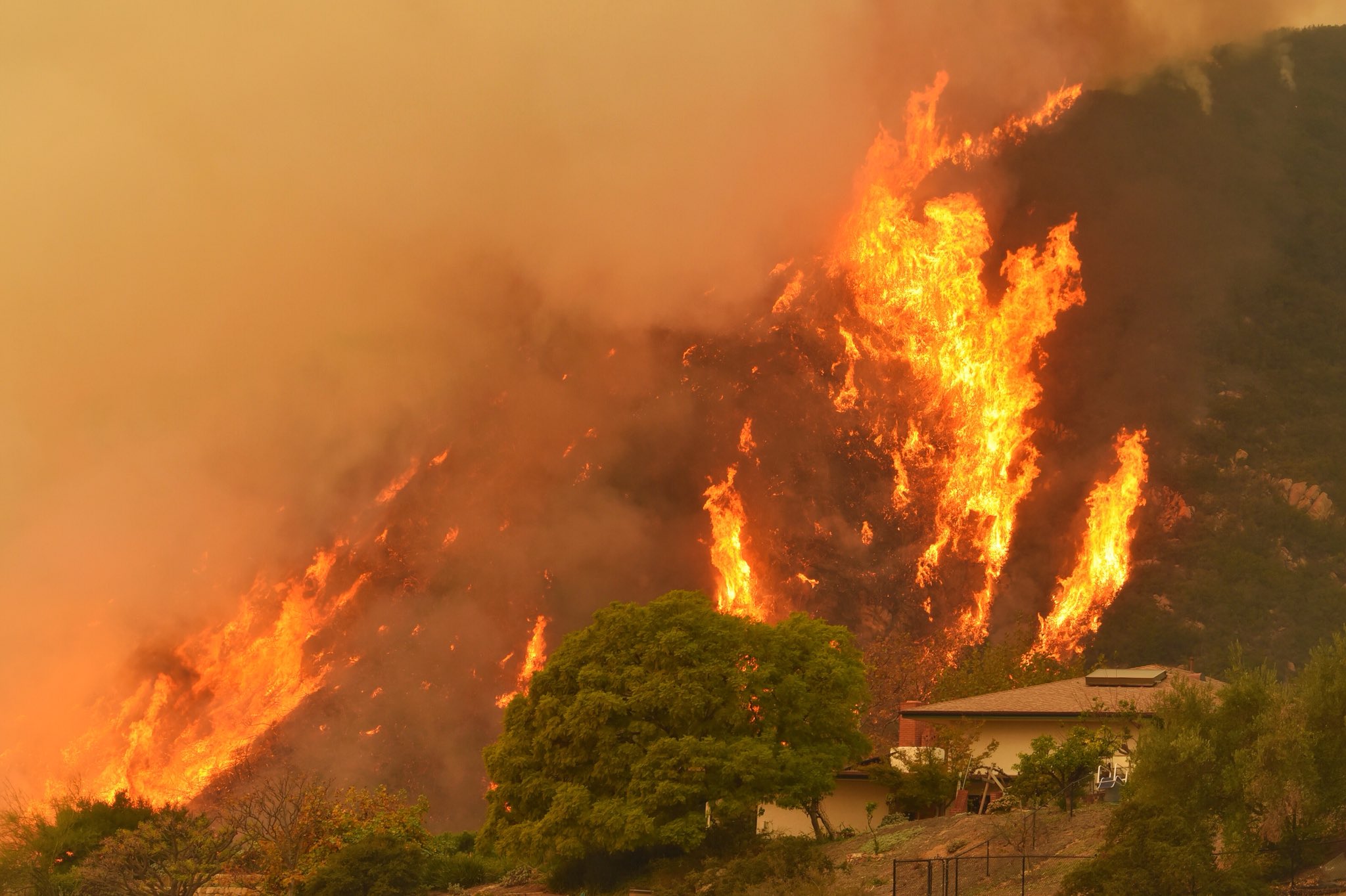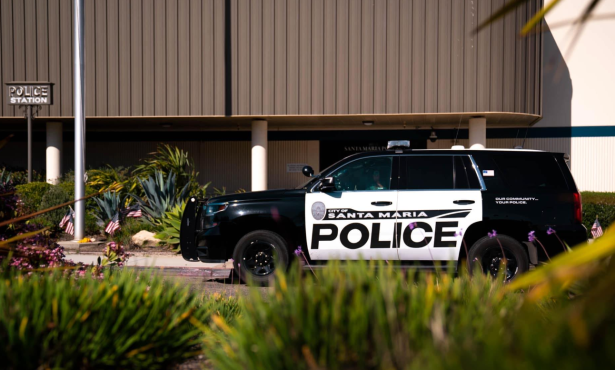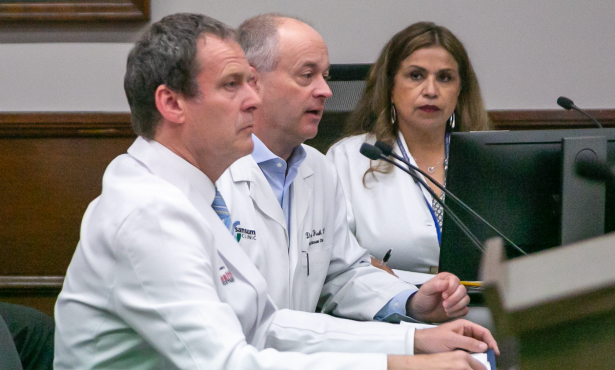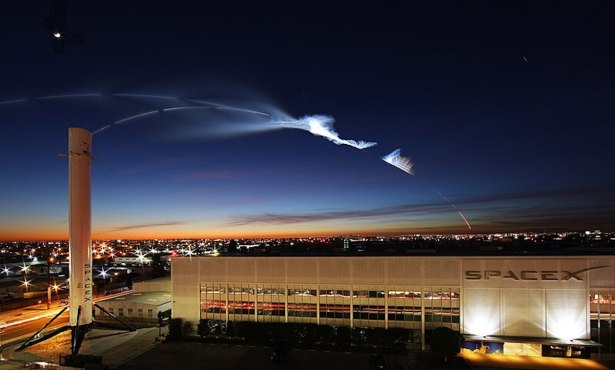Firefighters Go Mano a Mano with Thomas at San Ysidro Creek
Helicopters Have Success Bombarding Western Flank of Fire; Firefighter Dies on Eastern Edge

A lot of numbers got tossed around at Thursday evening’s community forum at San Marcos High School on the Thomas Fire, but only one was a statistic that really counted. As of today, 1 became the number of firefighters who died while fighting the Thomas blaze, now finishing its eleventh day terrorizing Ventura and Santa Barbara counties. Cal Fire engineer Cory Iverson of San Diego was identified as the fallen firefighter, though few details were released of the circumstances surrounding his death, other than general location.
Iverson was working the eastern flank of the fire, near Fillmore and the Sespe, an area that saw a flare up of activity on Thursday. Iverson was well-known and well-liked by several of the senior fire chiefs addressing the small crowd of elected officials, reporters, and community members attending the forum. Santa Barbara County Battalion Chief Chris Childers, whose wise-cracking sense of humor had on occasion landed him in trouble, struck a somber tone. “We had a very good day, but this was a very tough one for all of us,” Childers said. “It always hits hard when a firefighter dies.”
Undersheriff Bernard Malekian noted that relations between firefighters and law enforcement officers are typically marked by good-natured or competitive banter and ribbing. He then added, “Till you have a day like today when you’re reminded what the ultimate cost of this business is. It’s a tough business. It’s not an easy business.”
Iverson is the first firefighter to die in the Thomas Fire, and he is not the first casualty. Virginia Rae Pesola, a 70-year-old retired attorney who lived outside Ojai, died in a car accident while evacuating from the fire on December 5, shortly after it started.
The spread of fire on the western side was slow, though thick smoke kept fixed-wing air tankers out of action for all but a couple hours. “It wasn’t moving very fast,” said Childers. “It was creeping under the retardant.” Helicopters are far more nimble than planes and better able to adapt to smoke-choked skies. Twenty-seven helicopters were dispatched against Thomas, mostly attacking the western flank, which is several miles above Montecito’s “village” west of San Ysidro Creek. Forty-four handcrews attacked the fire, trying to cut a line around it. Each crew has 20 firefighters, each armed with chainsaws, axes, and a host of tools designed to strip the ground down to its mineral surface. The terrain was exceptionally steep, but the weather was somewhat cooler, and humidity levels — which dipped to one percent in previous days — had increased as well. This helped reduce the raw explosive power of the front-country brush, some of which hadn’t burned for 90 years.
Because of today’s success, incident commanders are holding off an aggressive contingency plan to fight the Thomas Fire by creating fire lines to contain about 7,000 acres of densely vegetated terrain before this weekend’s winds have a chance to push the Thomas Fire’s flames downslope. While many firefighting professionals favor this approach, the plan has generated some apprehension and considerable teeth-sucking by some community leaders, elected officials, and reportedly the Forest Service itself. “This looks less and less necessary,” said Battalion Chief Childers. “We’re having good luck with retardant and the lines.”
That option is not off the table, however. It all depends on the wind. The South Coast appears to have caught a significant break. The strong gusty winds predicted for Friday are now predicted for 12 hours later. If weather forecasts hold true, these northwest winds — gusting up to 50 miles an hour — won’t arrive until 2 o’clock Saturday morning and will depart around 6 a.m. Weather forecasts, however, are not always precisely correct. The fear is that these winds, whenever they arrive, could be strong enough to push the fire into Montecito and Santa Barbara. Should this contingency plan be implemented, it could involve a stretch of front country running from Santa Ynez Creek on the east to Gibraltar Road on the west. This approach has been used before in Malibu and a town in Australia reportedly very much like Malibu, said Rocky Oplinger with the Incident Command. Oplinger said he personally participated in the Australian effort, adding, “We didn’t lose a single structure.”
With more than 8,100 firefighters deployed, crews are currently gearing up to pursue either approach. On hand are more than 1,000 engines, 80 dozers, 50 water tenders, and 152 handcrews. Ordered and available were six large air tankers and two very large air tankers. The total number of acres involved is 249,500, making the Thomas Fire the fourth largest in recorded California history. The biggest — the Rush Fire in Lassen County — consumed 315,000 acres five years ago. Thomas stands at 35 percent contained.
The issue of street sweeping came up as well. When Santa Barbara city officials announced earlier this week they intended to resume street-sweeping operations, they heard loud objections from some members of the public noting that street sweepers’ upsweep would make intolerable air quality conditions that much worse. City officials have been meeting with Dr. Charity Dean of the County’s Public Health Department as well as staff with the Air Pollution Control District. The bottom line, said Dean, is that the ash has to be removed. She urged residents to avoid areas when street sweeping is taking place or to be sure to wear protective respiratory masks. Street sweepers, she said, have very strong vacuum pumps and filtration system. “This has to be done,” she concluded.
The issue of face masks came up again as well. At Wednesday evening’s community forum, a member of the public noted he’d never seen a firefighter ever wearing a face mask. If members of the public were being exhorted to take such precautions, why aren’t firefighters? At that point, Battalion Chief Childers quipped, “Nobody said we were geniuses.” On Thursday Childers revisited the issue. While touring the fire before the forum, he reported, “I did see a fire fighter wearing a face mask while I was up there. We’re not all dummies.”
The death of the Cal Fire engineer, however, was still weighing heavily, and Childers spoke about how firefighters now take more precautions. It used to be, he said, the crew members stayed on the job till the fire was put out. Now they work a fire 14 days — and never more than 21 — before they take a break to recuperate. “We do take care better,” he said. He noted that the invisible particulates emitted by fires cause damage to the lungs of the very young, very old, and the infirm. Firefighters, by contrast, tend to be young and extremely fit.



